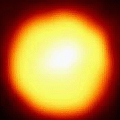







| BOOKS | F. A. Q. | ARTICLES | TALKS | ABOUT KEN | DONATE | BEYOND OUR KEN |
|---|
By Ken Croswell
Published in New Scientist (June 20, 1992, page 19).

Image by the Hubble Space Telescope. R. Albrecht (ESA/ESO Space Telescope European Coordinating Facility) and NASA.
Pluto is the only planet apart from Earth with an atmosphere consisting mostly of nitrogen, say astronomers from the U.S. and Europe. Their discovery offers clues to the origin of the solar system, because Pluto has changed little since its birth.
Pluto, the smallest planet, is at present 4.5 billion kilometers from the Sun, farther than any planet except Neptune. Its atmosphere was confirmed in 1988 when the planet passed in front of a star and dimmed the star's light gradually rather than abruptly (New Scientist, June 30, 1988). However, this event could not reveal the identity of the atmospheric gases.
Now a team of astronomers, led by Tobias Owen of the University of Hawaii, has discovered nitrogen ice on Pluto's surface (International Astronomical Union Circular, No. 5532). In the weak sunlight illuminating Pluto, some of the nitrogen ice must vaporize to produce a nitrogen atmosphere around the planet.
Owen and his colleagues observed Pluto on the nights of May 27 and 28 using the U.K. Infrared Telescope on Mauna Kea in Hawaii. They detected a weak spectral line at 2.15 micrometers, a wavelength absorbed by nitrogen ice.
Methane ice was discovered on Pluto in 1976, so methane gas must also make up part of its atmosphere. Owen's team found many spectral lines due to methane, which is easier to detect than nitrogen.
 But Owen and his colleagues say the dominant gas in Pluto's atmosphere must be nitrogen. Nitrogen has a much greater vapor pressure than methane, and the vapor pressure indicates the ease with which a solid can become gaseous at a given temperature. If Pluto's surface harbors both nitrogen ice and methane ice, Pluto's atmosphere must contain more nitrogen gas than methane gas, say the astronomers.
But Owen and his colleagues say the dominant gas in Pluto's atmosphere must be nitrogen. Nitrogen has a much greater vapor pressure than methane, and the vapor pressure indicates the ease with which a solid can become gaseous at a given temperature. If Pluto's surface harbors both nitrogen ice and methane ice, Pluto's atmosphere must contain more nitrogen gas than methane gas, say the astronomers.
Owen's team also discovered carbon monoxide ice on Pluto. Carbon monoxide has a vapor pressure intermediate between that of nitrogen and methane, so Owen and his colleagues believe that carbon monoxide is the second most abundant gas in Pluto's atmosphere.
"I think the discovery is very important," says Jonathan Lunine of the University of Arizona. He notes that interstellar clouds contain nitrogen, carbon monoxide, and methane--just as Pluto and Neptune's biggest moon Triton do. "What we're seeing is that these very cold, outermost objects have probably retained a lot of the original molecular mix of the interstellar cloud from which the solar system formed," he says. "So one can use these objects as chemical probes of the processes by which the solar system originated."
Two worlds, other than the Earth and Pluto, have nitrogen atmospheres, but they are moons rather than planets: Titan, Saturn's biggest moon, and Triton. Like Pluto, Triton also has carbon monoxide ice.
"Pluto and Triton seem to have the same substances on their surfaces and in their atmospheres," says Lunine, "and that strongly suggests Pluto and Triton are of the same ilk." Since 1989, astronomers have known that Pluto and Triton also have nearly the same size, mass, and density.
Even with the new discovery, Pluto remains a mysterious planet, because no spacecraft has yet flown past it. But American scientists hope to launch a spacecraft in 2001 that would reach Pluto in 2015 (Astronomy, May 1992, page 34). [UPDATE: The spacecraft was successfully launched on January 19, 2006; arrival at Pluto is still set for 2015.]
Ken Croswell earned his Ph.D. in astronomy from Harvard University and is the author of Magnificent Universe and Magnificent Mars.
"Elegant and eloquent"--The Washington Post. See all reviews of Magnificent Universe here.
| BOOKS | F. A. Q. | ARTICLES | TALKS | ABOUT KEN | DONATE | BEYOND OUR KEN |
|---|